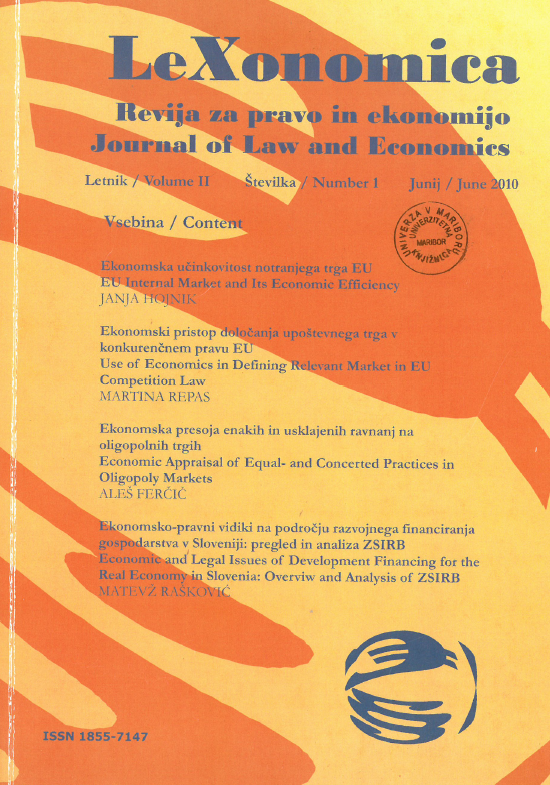Ekonomska učinkovitost notranjega trga EU
Keywords:
competition law, relevant market, supply-side, SSNIP test, cellophane fallacy, cross-price elasticity, price correlationAbstract
EU internal market and its economic efficiency. Process of regional economic integration in Europe has in the last decades been determined by expansions in various dimensions – substantially as well as geographically. Market integration is thereby presented as an instrument to enhance prosperity. The article analyses economic effect of the EU internal market, i. e. whether and to what extend has the internal market enhanced economic prosperity and income in Europe in the last half-century. From methodological point of view we are dealing with a very complex question, which has been approached in various ways by various economic studies. The article is based on a study performed by a Dutch bureau CPB, which was assessing additional economic effect of the EU internal market – i.e. in addition to alternative forms of market integration, existing also in economic relations with third countries. The authoress concludes that the EU internal market has achieved the highest economic effect in the field of foreign direct investments; economic effect of free movement of goods is comparable to foreign direct investments, whereas the economic effect of free movement of services is being more moderate, however, having considerable potential for increase. Economic effect of free movement of workers is not analysed in the article considering low level of migration flows between the EU member states.
Povzetek. Proces regionalne ekonomske integracije v Evropi je v zadnjih desetletjih zaznamovalo širjenje v različne dimenzije, tako vsebinsko kot geografsko. Pri tem je tržna integracija EU predstavljena kot sredstvo za povečanje blaginje. Prispevek presoja ekonomski učinek notranjega trga EU - tj. povrh alternativnih oblik tržne integracije, ki obstajajo tudi v gospodarskih odnosih s tretjimi državami. Avtorica v prispevku ugotavlja, da je notranji trg EU dosegel najvišji ekonomski učinek pri tujih neposrednih naložbah; ekonomski učinek prostega pretoka blaga je primerljiv s tujimi neposrednimi naložbami, medtem ko je ekonomski učinek pretoka storitev nižji, vendar ima znatni potencial za povečanje. Ekonomski učinek svobode gibanja delavcev zaradi majhnega obsega migracijskih tokov med državami članicami EU v prispevku ni obravnavan.
Downloads
References
Armstrong, K. A., Bulmer S. (1998), Manchester University Press.
Armstrong, K. A. (1999) Governance and the Single European Market, v: Craig, P., de Burca, C. (ur.), The Evolution of EU Law, Oxford University Press, 745.
Barnard, C. (2004) The substantive law of the EU: the four freedoms, Oxford University Press.
Burley, A.-M., Mattli, W. (1993) Europe Before the Court: A Political Theory of Legal Integration, 47 International Organization, 41.
Business in Europe: On the Defensive, The Economist, 8. 6. 1991, 10.
Cecchini, P. (1988) The European Challenge 1992: The Benefits of a Single Market, Aldershot, Wildwood House, 4.
Craig, P., de Burca, G. (2003) EU Law (London: Sweet & Maxwell Publishing).
Craig, P. (2002) The Evolution of the Single Market, v: Barnard, C., Scott, J. (ur.) The Law of the Single European Market, Unpacking the Premises, (Oxford: Hart Publishing), 1. Eichengreen, B., Boltho, A. (2008) The economic impact of European integration, CEPR Working Paper 6820.
European Commission (2007) European Economy, Economic papers, No. 271.
Eurostat (2006), European Union foreign direct investment yearbook, Luksemburg.
Eurostat (2008), Europe in figures – Eurostat Yearbook, 2008, Luksemburg.
Garrett, G. (1992) International Cooperation and Institutional Choice, EC Internal Market, International Organization, 538.
Gormley, L. W. (1997) The Internal Market: Achievement or Delusion?, v: Emiliou, N., O’Keeffe, D. (ur.), Legal Aspect of Integration in the European Union, Kluwer Law International, 107.
Grilc, P. (2004) Pravo Evropske unije, 2. knjiga, (Ljubljana: Cankarjeva založba.
Hindelang, S. (2009) The Free Movement of Capital and Foreign Direct Investment, The Scope of Protection in EU Law, Oxford University Press.
Hoeller, P., Louppe, M.-O. (1994) The EC's Internal Market: Implementation and Economic Effects, OECD Economic Studies No. 23.
Hussain, M., Istatkov, R. (2009) Internal market still accounts for more than 50% of EU foreign direct investments and trade in service, 56 Eurostat 1.
Knez, R., Hojnik, J. (2009) Notranji trg EU (Maribor: Pravna fakulteta).
Kox, H., Lejour, A., Montizaan, R. (2005) The free movement of services within the EU, CPB Netherlands Bureau for Economic Policy Analysis 34.
Lejour, A., Solanic, A., Tang, P. (2006) EU accession and income growth: an empirical approach, CPB Discussion Paper 72.
Molle, W. (1997) The Economic of European Integration: Theory, Practice, Policy, 3. izdaja, (Ashgate: Aldershop).
Moravcsik, A. (1991) Negotiating the Single European Act: National Interests and Conventional Statecraft in the European Community, 45 International Organization 19.
OECD (2008) Code of Liberalisation of Capital Movements iz leta 1961 – dostopno na: http://www.oecd.org/dataoecd/21/23/38072327.pdf (obiskano 13.3.2010).
OECD (2008) OECD Benchmark Definition of Foreign Direct Investment, 4. izdaja, dostopno na: http://www.oecd.org/dataoecd/26/50/40193734.pdf (obiskano 2. 2. 2010).
Patterson, N. et al. (2004) International Monetary Fund.
Sandholtz, W., Zysman, J. (1989) 1992: Recasting the European Bargain, 42 World Politics 95.
Straathof, B., Linders, G.-J., Lejour, A., Möhlmann, J. (2008), The Internal Market and the Dutch Economy, Implication for trade and economic growth, CPB Document, št. 168 Foreign Direct Investment, Trends, Data Availability, Concepts, and Recording Practices.
Usher, J. (2000) The Law of Money and Financial Services in the European Community, (Oxford: Claredon Press).
Van Houdt, P. (1998) Did the European Unification Induce Economic Growth? In Search of Scale-Effects and Persistent Changes, SSE/EFI Working Paper Series in Economics and Finance, Vol. 270.
Downloads
Published
Issue
Section
License
© Univerza v Mariboru, Pravna fakulteta, Univerzitetna založba
Prosti pristop
